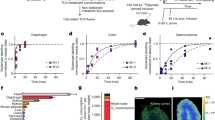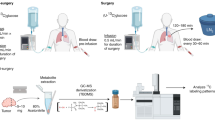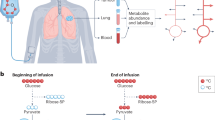Abstract
pH frequency distributions of tumours grown s.c. from 30 human tumour xenograft lines in rnu/rnu rats were analysed with the use of H+ ion-sensitive semi-microelectrodes prior to and following stimulation of tumour cell glycolysis by i.v. infusion of glucose. At normoglycemia, the average pH of the tumours investigated was 6.83 (range, 6.72-7.01; n = 268). Without exception, all xenografts responded to the temporary increase in plasma glucose concentration (PGC) from 6 +/- 1 to 30 +/- 3 mM by an accumulation of acidic metabolites, as indicated by a pH reduction to an average value of 6.43 (range, 6.12-6.78; n = 292). This pH value corresponds to a ten-fold increase in H+ ion activity in tumour tissue as compared to arterial blood. Tumour pH approached minimum values at 2-4 h after the onset of glucose administration and could be maintained at acidic levels for 24 h by controlled glucose infusion. Irrespective of pH variations between tumours grown from individual xenograft lines, there was no major difference in pH response to glucose between the four main histopathological tumour entities investigated, i.e. breast, lung and gastrointestinal carcinomas, and sarcomas. In tumours from several xenograft lines, an increase in blood glucose to only 2.5-times the normal value (14 mM) was sufficient to reduce the mean pH to 6.4. Glucose-induced acidosis was tumour-specific. The pH frequency distributions in liver, kidney and skeletal muscle of tumour-bearing rnu/rnu rats were only marginally sensitive to hyperglycemia (average pH, 6.97 vs normal value of 7.14). Tumour-selective activation of pH-sensitive anti-cancer agents, e.g. alkylating drugs, acid-labile prodrugs or pH-sensitive immunoconjugates may thus be feasible in a wide variety of human cancers.
This is a preview of subscription content, access via your institution
Access options
Subscribe to this journal
Receive 24 print issues and online access
$259.00 per year
only $10.79 per issue
Buy this article
- Purchase on Springer Link
- Instant access to full article PDF
Prices may be subject to local taxes which are calculated during checkout
Similar content being viewed by others
Author information
Authors and Affiliations
Rights and permissions
About this article
Cite this article
Volk, T., Jähde, E., Fortmeyer, H. et al. pH in human tumour xenografts: effect of intravenous administration of glucose. Br J Cancer 68, 492–500 (1993). https://doi.org/10.1038/bjc.1993.375
Issue Date:
DOI: https://doi.org/10.1038/bjc.1993.375
This article is cited by
-
Glucose Infusion Induced Change in Intracellular pH and Its Relationship with Tumor Glycolysis in a C6 Rat Model of Glioblastoma
Molecular Imaging and Biology (2023)
-
Antitumor effects of lactate transport inhibition on esophageal adenocarcinoma cells
Journal of Physiology and Biochemistry (2023)
-
Recent advances of bioresponsive polymeric nanomedicine for cancer therapy
Nano Research (2023)
-
Quantitative imaging of intracellular nanoparticle exposure enables prediction of nanotherapeutic efficacy
Nature Communications (2021)
-
PET imaging of occult tumours by temporal integration of tumour-acidosis signals from pH-sensitive 64Cu-labelled polymers
Nature Biomedical Engineering (2019)



